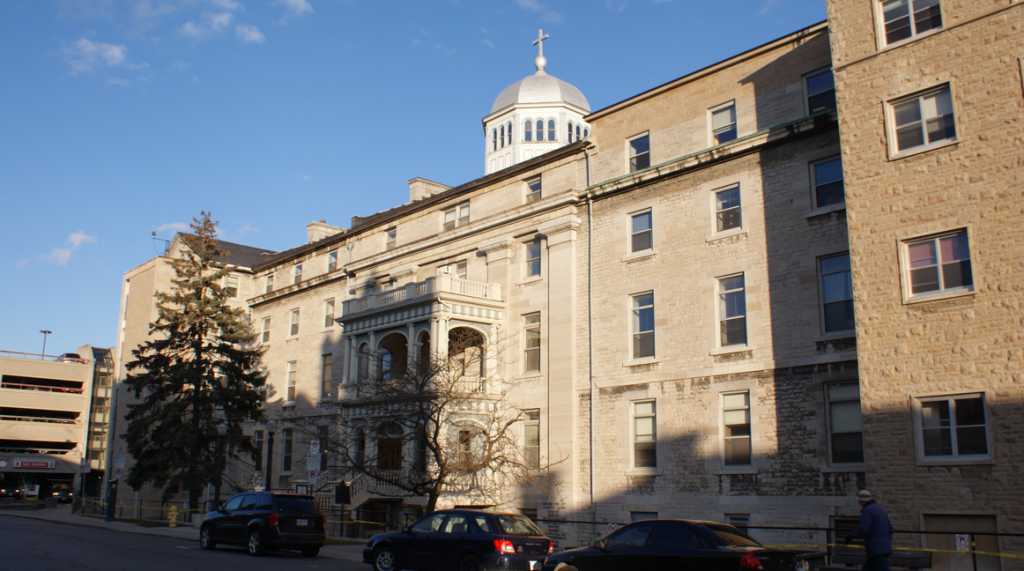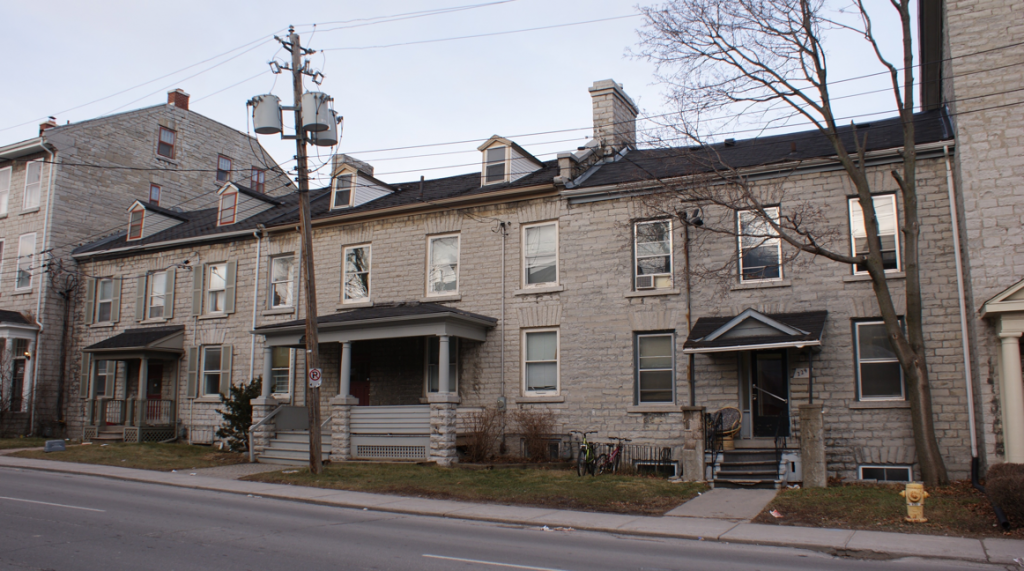Period: 1800-1850
Hotel Dieu Hospital, which still exists in Kingston today, is one of the most prominent examples of the importance of the contributions of French Canadians to the Kingston community. Kingston, by the mid-19th century, was severely lacking in medical care, especially with the increased immigration of Irish Catholics in the area. Many of these Catholics were too poor to afford medical care, and as such Father Remi Gaulin, Kingston’s second Catholic bishop, decided in 1841 that it was high time to create a Catholic hospital for his flock. Father Gaulin sent word to the Religious Hospitallers of St. Joseph, a group of Catholic nuns who had been recruited to work at Hotel Dieu Hospital in Montreal almost 200 years before, to ask them to send Sisters to Kingston to establish a Catholic Hospital to aid the poor Catholics. His prayers were answered, but not before the Bishop of Montreal, Father Ignace Bourget, visited Kingston to analyze the situation and deemed it almost too dire for the Sisters to be able to do anything. Bishop Bourget warned the Sisters of the difficulties that they would encounter in the Ontario town, but this did not deter them, and the Sisters agreed to offer their services to go to Kingston and establish a hospital.
Funds for this mission were low, however, and Sisters were unable to leave for Kingston until 1845, when a laywoman, Miss Josephine Perras offered her fortune to the cause. With this money, Sister Bourbonnière, the Kingston Foundress, was able to travel to Kingston with Miss Perras and a Mr. Laframboise in May of that year to buy the properties that would serve as the first location of Hotel Dieu Hospital. The party was greeted off the steamship by Father Patrick Phelan, the successor of Father Gaulin, and went to work the day following their arrival, buying the properties at 229 and 233 Brock Street. They then all three returned to Montreal at the end of the month of May to recruit more Sisters for the mission. The community elected the three Sisters (Sisters Louise Davignon, Huguette Claire Latour, and Emilie Barbari) who would accompany Sister Bourbonnière back to Kingston a few months later. On September 1st, 1845, the four Religious Hospitallers of St. Joseph, once again escorted by Miss Perras and Mr. Laframboise, left Montreal for Kingston, where they were able to move into their small ward at 229 Brock Street three days later. After four long years of waiting, Hotel Dieu Hospital was finally becoming a reality, with the first patient being admitted on September 12th.
Though the funds had been raised and the hospital had been successfully established, this was by no means the end of the Sisters’ problems during their time in Kingston, quite the contrary. The space that they were made to live in was much too small for four people to live in comfortably, and the food that they were being fed was poor. Two of the Sisters fell ill within the first few weeks of living in Kingston. The ward in which the Sisters lived was so small that after two months of them living there, it was decided that they should move into 233 Brock Street, which was larger than the building at 229 Brock Street. 229 became the hospital from then on, with the men’s ward being located on the main floor and the women’s ward on the second floor. The lack of space, since 229 Brock Street was such a small building, meant that the Sisters sometimes had to turn patients away. Hearing the Sisters’ plight, a certain Captain Hunter started raising funds to help the hospital, and was so successful that his campaign singlehandedly funded the construction of Hotel Dieu’s first wing, 231 Brock Street, in 1847. The Kingston community also contributed in aiding the hospital in other ways: some donated furniture, others gave food.
In 1847, disaster struck Kingston in the form of a typhus epidemic. The Sisters were unable to care for all the sick who came to their door, as 231 Brock Street was still under construction, so they resorted to caring for the increasing number of patients in sheds built by the waterfront. Being in such close proximity to the disease, however, meant that every single one of the four Sisters contracted typhus at one point or another. The situation was so dire that they had to send for help, asking the Mother House in Montreal to send reinforcements, and two more Sisters were sent over to Kingston in the fall. The typhus epidemic of 1847 also meant that a significant number of children of the Kingston community lost either one or both parents to the disease. As such, on Christmas Eve of that same year, approximately 100 orphans were brought to Hotel Dieu to stay until other accommodations could be found for them. However, the hospital was not equipped to deal with such an influx of young children who could not take care of themselves, and not enough cots were available for them to sleep in. The Kingston community, once again, came to the aid of the Sisters, providing clothing and bedding for the children. More than half of the children were claimed by various family members over the next year, and most of the others were placed in families by April of 1849. 1847 marks the beginning of Hotel Dieu Hospital acting not only as a hospital, but also as an official Catholic orphanage funded in part by the government, a role which the hospital retained until 1910 when the orphanage at St. Mary’s of the Lake opened its doors.
The next decade and a half passed in relative calm, though the hospital still lacked significantly in funds. In 1863, after having dealt with a smallpox epidemic earlier that year, the original Religious Hospitallers of St. Joseph returned to Montreal, leaving behind the hospital in the hands of five Sisters who had trained under them. Over the next 10 years, the Sisters began considering expanding their hospital once more, and so, after much deliberation with the Catholic Bishop, construction of a new wing began in 1872. By the end of the century, the hospital could hold 80 patients. Not only was Hotel Dieu still under financial strain, and the staff of 50 Sisters was not enough to fulfill all the duties required, but the hospital building was too small to meet the needs of the growing Kingston population. Thus, plans began to move the hospital into new facilities, and the Sisters were made aware that the building where Regiopolis College had previously been housed was available to them. The building itself needed to be renovated and a church needed to be built close to it for the use of the hospital. The Sisters bought the site, in addition to the land surrounding it, and moved in in 1892, after the renovations were complete. Here ends the story of the first location of Hotel Dieu Hospital in Kingston, and the beginning of the history of the hospital at its current location on Sydenham Street.
After 18 years in their new facilities, it became clear to the Sisters that they could not care for all of the incoming patients alone, which led to the creation of St. Joseph’s School of Nursing. The Nursing School was not the only addition made to the new hospital facilities. Indeed, the decades that followed the move into the old Regiopolis building were filled with expansions of the hospital: in 1894, a chapel was built, in 1899, a surgical theatre was built, in 1909, the Brock Street wing was added (which had private rooms for patients), in 1923, a nurses’ residence was built, and in 1931, St. Joseph’s wing opened (which housed the outpatient, x-ray, cardiology, urology, and dental departments as well as more private patient rooms). In 1940, the first elevator was installed. During World War II, significant sections of the hospital were used to house injured soldiers, and additional beds were paid for by the government following the war for follow-ups on soldiers’ physical health. The largest most recent addition to the hospital was its current main wing, the Jeanne Mance Wing, built in 1984, and named after the laywoman who founded the original Hotel Dieu in Montreal in 1645.
The organization of the hospital has much changed in its 170 years of existence. The medical staff was divided into departments when Hotel Dieu first joined the Catholic Hospital Association in 1918. A few years later, all hospitals became standardized in Canada, Hotel Dieu being one of the first and being recognized for its excellence. In 1955, after almost 100 years of connection to Queen’s School of Medicine through teaching clinics, the hospital became a full-fledged associate of the School of Medicine and benefited from increased grants from the government because of this affiliation. Thus, in the last 170 years, Hotel Dieu Hospital has transformed from a community hospital run by the Religious Hospitallers of St. Joseph in two relatively small buildings in Brock Street, to a fully-functional and modern teaching hospital.



